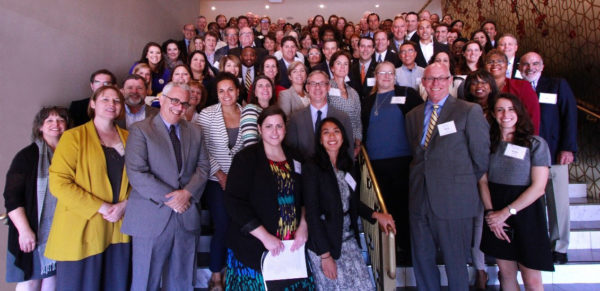The American Talent Initiative’s Fall 2017 Strategic Support Meeting
Convening Member Institutions for Collaborative Practice-Sharing
Earlier this month, more than 100 representatives from American Talent Initiative (ATI) member institutions and partner organizations convened in Washington, D.C. The meeting, run by The Aspen Institute and Ithaka S+R, was designed to give participants the opportunity to learn more about the progress of the initiative and to work collaboratively to advance practice in the key ATI focus areas (outreach, enrollment, financial aid, and retention/graduation). The initiative’s collective goal, adding an additional 50,000 low- and moderate-income students at top-performing colleges and universities by 2025, grounded discussion over the course of the two-day meeting.

Meeting participants gather for a group photo. Photo credit: The Aspen Institute
Meeting Agenda
The meeting began with an evening reception that featured a panel on the student experience, offering an opportunity for attendees to hear directly from two current students about the challenges they face getting to and succeeding on campus as students from first-generation and low-income families. In addition, a recent college graduate, who now serves as an advisor of talented low-income high school students with the College Advising Corps, provided insight into the roadblocks faced during the application process. This panel was not only informative and inspiring, but set the tone for the next day, reminding attendees that students should be at the center of the work moving forward.
The next day commenced with a plenary session that provided an overview of ATI members’ goals related to improving lower-income student access and success on their campuses, previewed aggregate data on trends and progress in enrolling lower-income students over time, and introduced a “Design Thinking” framework for problem solving and innovation conversations throughout the day. Participants chose between two concurrent sessions: Financial Aid Communications, where participants discussed how they each engage in effective approaches for conveying information about affordability and financial aid, and High-Impact Experiences, where participants discussed challenges and strategies for prioritizing lower-income student engagement with meaningful experiences on campus. Each session featured a panel of attendees with demonstrated expertise in these areas in these areas.
During lunch, participants were given the opportunity to “Lunch and Learn” with ATI’s companion initiative, CollegePoint, and external partners: The Common Application, Phi Theta Kappa, College Advising Corps, College Greenlight, and MyinTuition. This allowed for networking and sharing of ideas amongst participants about how each institution can strengthen the pipeline for lower-income students to each ATI college and university.
A second set of concurrent sessions was held after lunch: Early Student Success, which included a panel discussion of best practices on improving lower-income student retention, and Building Community College Transfer Success, where ATI staff shared early findings from research focused on building community college transfer to ATI member institutions.
The day concluded with the opportunity for participants to form advisory groups with their colleagues on topics of interest. Topics included, but were not limited to, developing community college partnerships, reducing barriers for lower-income students to participate in high-impact experiences, exploring how to define “moderate income,” and creating a sense of belonging among lower-income students on campus. Participants self-selected into groups based on their particular interests, and worked collaboratively for the remainder of the session on the specific steps they could take at their institutions to further work on this topic.
Key Takeaways
Some of the key takeaways that emerged from the meeting include:
- Participants were extremely appreciative of the opportunity to network with colleagues, and were inspired by the degree to which goals were shared across ATI members. The diversity of the ATI membership allowed colleagues to work together who normally wouldn’t have the opportunity to interact.
- There was a consensus for more work to be done as an ATI community, acknowledging that participants represent institutions that, together, have the ability to affect great change. During the meeting, participants identified priority areas where collective work could be accomplished, and after the meeting, had a chance to opt into a group based on those topics.
- Participants were inspired to revise their institution-specific goals following the meeting, particularly to set more concrete, measureable targets to measure their success over time.
- The role that a participant fills at their institution (e.g. admissions, financial aid, etc.) influences their perspectives and the challenges they face. This meeting brought together participants from a variety of different campus offices, showcasing the value of having different perspectives at the table.
The ATI Team is also currently preparing for a convening of ATI member institutions’ Institutional Research representatives, to be held later this month. We look forward to sharing more on the takeaways from both of these meetings, and the work of ATI more broadly, as the fall progresses.